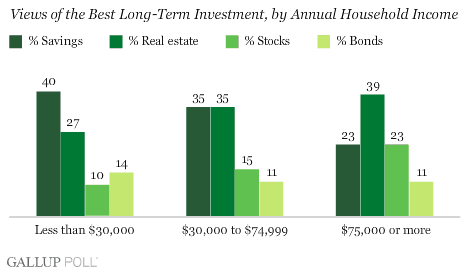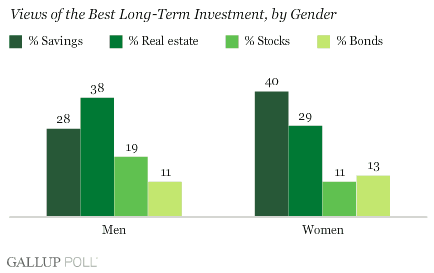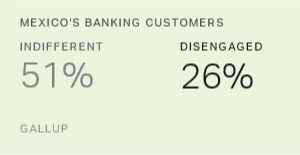PRINCETON, NJ -- When asked which of four common investments is best for the long term, Americans divide equally between savings accounts and real estate, with fewer choosing stocks or mutual funds as well as bonds.

These results are based on Gallup's annual Economy and Personal Finance poll, conducted April 6-9, and reflect the reality of the U.S. investment climate. Stocks have lost much value over the past year and real estate prices have continued to fall. While savings accounts usually offer little return on the invested money, the fact that they return anything has probably made them a better investment in recent years than either stocks or real estate.
Savings accounts have ranked first or tied for first the last three times Gallup has asked this question, including last September, during the height of the financial crisis, and in last year's Economy and Personal Finance poll. Prior to that, savings accounts ranked no better than third among the four options.

There has been some recovery in perceptions of real estate as the best long-term investment -- it dipped to a low of 26% last September but now is at 33%. Americans may believe that the housing market is beginning to pick back up. A separate question in the poll found 71% saying now is a good time to buy a house, up 18 points from a year ago and the highest since 2005.
But even with the improvement this year, housing still ranks well below where it did during the real-estate boom years -- in 2002, 50% of Americans said housing was the best long-term investment.
Similarly, stocks have lost some of their luster in recent years. In the 2007 Economy and Finance survey, 31% of Americans chose stocks as the best long-term investment. But that percentage has declined in each of the three polls since then, and has hit a new low of just 15%. Since the poll was conducted, stocks have recovered some of their lost value, but this remains much lower than before the financial crisis took hold.
Bonds -- like savings accounts -- tended to perform better than most other investments in the past year, but Americans' perceptions of bonds as the best long-term investment have varied little in response to economic conditions, ranging between 10% and 13% since 2002.
Subgroup Differences
Americans' perceptions of the best long-term investment vary to some degree, depending on their demographic characteristics. For example, upper-income respondents are most likely to view real estate as the best investment, while lower-income respondents choose savings accounts. Middle-income Americans are equally divided between savings accounts and real estate.

Men and women also differ as to which of the four is the best investment in the long run, with men most likely to say real estate and women savings accounts.

Over the years, women and lower-income Americans have been more inclined than men and upper-income respondents to view savings accounts as the best long-term investment. Meanwhile, men and wealthier Americans have been more likely than women and lower-income Americans to view real estate and stocks as having greater long-term potential
Implications
Americans' perceptions of the best long-term investment have shifted in line with changes in the real-world performance of the most common investments. Earlier this decade during the housing boom, real estate was the runaway winner as the best investment in Americans' minds, but as housing prices dropped, so did faith in real estate. It has recovered somewhat this year as Americans perceive an improving housing market.
The huge losses in stock investments over the past year have caused Americans to downgrade stocks, and as of the early April date of these results, the percentage of Americans viewing stocks or mutual funds as having the greatest long-term potential has hit a new low.
These changes have allowed savings accounts to gain in popularity, and thus a low-risk, low-reward investment now ranks at the head of the pack in terms of being viewed as the best long-term investment.
Survey Methods
Results are based on telephone interviews with 1,027 national adults, aged 18 and older, conducted April 6-9, 2009. For results based on the total sample of national adults, one can say with 95% confidence that the maximum margin of sampling error is ±3 percentage points.
Interviews are conducted with respondents on land-line telephones (for respondents with a land-line telephone) and cellular phones (for respondents who are cell-phone only).
In addition to sampling error, question wording and practical difficulties in conducting surveys can introduce error or bias into the findings of public opinion polls.
